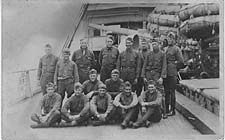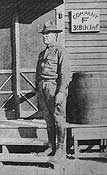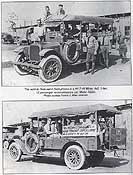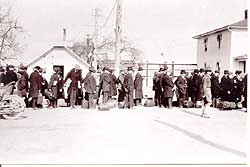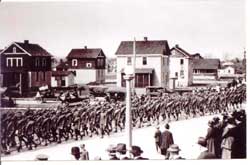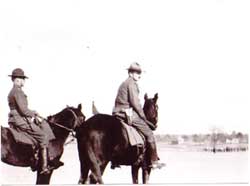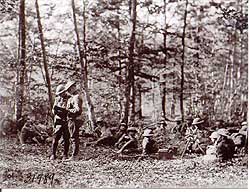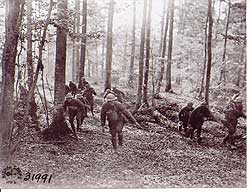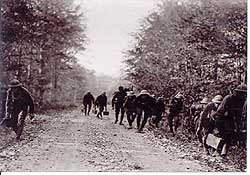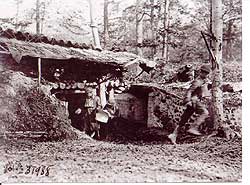


The 80th Division, a National Army Division, was organized at Camp Lee, near Petersburg, Virginia in September 1917, with Major-General Adelbert Cronkhite, commanding. The Division was organized as follows:
159th Infantry Brigade: 317th Infantry Regiment, 318th Infantry Regiment, 313th Machine Gun Battalion.
160th Infantry Brigade: 319th Infantry Regiment, 320th Infantry Regiment, 315th Machine Gun Battalion.
155th Field Artillery Brigade: 313th Field Artillery Regiment (75mm), 314th Field Artillery Regiment (75mm), 315th Field Artillery Regiment (155mm), 305th Trench Mortar Battery.
Divisional Troops: 314th Machine Gun Battalion, 305th Engineer Regiment, 305th Field Signal Battalion, 305th Train Headquarters and MP, 305th Ammunition Train, 305th Supply Train, 305th Engineer Train, 305th Sanitary Train (Ambulance Companies & Field Hospitals 317, 318, 319, 320).
The enlisted personnel of the 80th Division were draftees drawn from Virginia, West Virginia and the western counties of Pennsylvania, giving the division the name of "The Blue Ridge Division."
The Division suffered 1,241 men killed in action; 4,788 men wounded in action; 100 men as prisoners of war or missing in action. There were 4,495 men received as replacements. The Division advanced a total of 24 miles and captured a total of 1,813 German prisoners of war.
Summary History of the 318th Infantry Regiment
Co. A., 318th Infantry, April 1918
From the collection of Vincent PettyFrom the start the 159th Infantry Brigade was known as a Virginia organization as all of its original enlisted personnel were drawn from the Commonwealth. The men of the 317th Infantry were drawn from the western counties of Virginia while the men of the 318th were drawn from the eastern counties of Virginia.
The 318th Infantry Regiment was organized September 5, 1917 at Camp Lee near Petersburg, Virginia. The men arrived in allotments until full strength was achieved. Five percent the first week, 15% the second, 25% the third week and the remainder the forth week. By October 1917 the 318th Infantry was at full strength. Company A was the first to be mustered into service followed by Company E. In November 1917 to bring divisions, about to leave for France, up to strength, 1,000 men were taken from the 318th. About April 1, 1918 to bring the regiment back up to strength a new draft of men was received. Nearly all of these men were from Pennsylvania.
On May 20, 1918 the 318th Infantry entrained for Hoboken, New Jersey and on May 22, 1918 sailed for France on the Leviathan. The Regiment arrived at Brest on May 30 and disembarked from its transport on May 31, 1918. It camped at Pontanazen Barracks before moving to Calais and a British camp known as West Camp No. 6. Here the Regiment turned in their American rifles and bayonets and drew British rifles and bayonets, British gas masks and drew steel helmets. Auto rifle sections drew the Lewis gun. On June 7-10, 1918 the 318th moved to the Samer Area for training with the British Army, training with the 16th (Irish) and 34th Divisions BEF. July 5, 1918 the regiment moved to Candas and continued training with the 19th Battalion of the Kings Regiment, 66th Division BEF until July 22, 1918. One July 22 the regiment passed from training in the rear to finally going into the trenched with the British Army. The Regiment moved to the forward zone of Rubempre, training with the 17th Division and the 38th (Welsh) Division BEF. During this period the platoons of each battalion were fed into the lines; 2nd Battalion platoons from July 27-31; 3rd Battalion platoons from July 31-August 4; 1st Battalion platoons from August 8-12. In this advanced training the 2nd Battalion suffered the first casualties of the Regiment with 4 killed and 5 wounded. The 3rd Battalion suffered one officer killed, one man killed and 7 men wounded. 1st Battalion suffered one officer and two men wounded. On August 12th the full 2nd Battalion when into the lines relieving the 14th Royal Welsh Fusiliers. On August 13, 1918 heavy hostile artillery fell on the 2nd Battalion resulting in casualties. The 2nd Battalion was relived on the night of August 18, 1918. Before the 3rd and 1st Battalions could enter the lines as full battalions the 318th (and 80th Division) was recalled by the American Army on August 19.
On August 19 and 20, 1918 the 318th Infantry moved to Domleger and on arrival in this area turned in their British rifles and bayonets and again drew their American ordnance. On August 21 and 22 the regiment moved to the American Sector. On August 23 and 24 the Regiment arrived with regimental and battalion headquarters at Recey-sur-Ource, Gurgy-le-Chateau and Colmiers-le-Haut, respectively. It was here that the 318th Infantry received the Chauchat auto rifle for the first time. On August 31 the Regiment marched to Dancevoir then to Latrecey. By September 7 the regiment was in the Resson area.
September 12-14 the American Army fought its offensive on St. Mihiel. During this drive the 318th Infantry and the bulk of the 80th Division were in reserve (though records indicate the 320th Infantry and 315th Machine Gun Battalion were engaged). On September 15 the Regiment embussed at Culey for Relamee Woods near Souilly. By September 25 the Regiment was in position south of Bois Bourrus on the Germonville-Vigneville Road.
September 26, 1918 the 80th Division went into action in the Meuse-Argonne Offensive. The 318th Infantry was held in reserve early in the offensive but on September 29 was sent to support the 8th Infantry Brigade of the 4th Division, fighting with the 4th until the 3rd of October. On the October 3 the 2nd and 3rd Battalions of the 318th were withdrawn and returned to the 80th Division for an attack to be made on October 4, while the 1st Battalion remained in support of the 59th Infantry Regiment, 4th Division returning to the regiment on October 5. The 318th was in action as part of the 4th Division and 80th Division from September 29 until the night of October 6/7 when it was relieved. During this period the Regiment suffered 7 officers and 101 men killed, 25 officers and 807 men wounded and 2 men missing. The 2nd Battalion had lost all of its company commanders and about 60% casualties and the 3rd Battalion had suffered as heavily.
On October 7 the regiment was relieved and the day was devoted to resting and relaxing and hot meals. On October 8 the regiment moved to Bois de Montfaucon. Here several officers rejoined the regiment from various army schools and new officers joined the regiment. The regiments strength was so greatly reduced that companies were at once reorganized on the basis of three small platoons per company and a certain amount of drilling was carried out on these reduced conditions. On October 11 the Regiment moved to Bois de Hesse arriving there on the night of the 11th and remaining until the morning of October 14 when it marched to Dombasle and there embussed for the Vaubecourt area. Here the regiment received a new issue of clothing with overcoats. It was also at Vaubecourt that the regiment received the Browning Automatic Rifle. The 318th remained in this area until October 24 when it was moved to Islettes les Petites.
By the night of October 31 the regiment was in line again and on November 3 was ordered to advance, continuing the advance by battalions a total of 16 kilometers until November 6. During these three days in line the Regiment suffered 5 officers and 20 men killed, 9 officers and 84 men wounded and 1 man missing.
One the morning of November 6 the 80th Division was relieved by the 1st Division. The men of the 80th Division were shocked that they were taken out of line at this time. They never knew why they were pulled, but since that time believed that they were pulled out so that the 1st Division could be on the line when the Armistice came through.
With the Armistice the Regiment was ordered to the 15th Training Area with Division HQ in Ancy-le-Franc, reaching there on the night of November 29. During this march the Regiment received 583 replacements. The Regiment remained in this area for about four months. Throughout the winter the Regiment continued training and also competed in various horse shows. On March 26, 1919 the Division was reviewed by General Pershing. On April 3 and 4 left the 15th Training Area for Mayet; an area known as the American Embarkation Center. It was at Mayet that the 318th Infantry was actually able to finish its regular rifle courses with the M1917 Rifle. On April 21 the inspectors of the Embarkation Center made their last inspections and on May 8 the entire Regiment was inspected and reviewed by Major-General Cronkhite. From May 13-15 the Regiment left Mayet for Brest and all units were in camp at Pontanezen by May 16 - Almost a year since they first arrived at Pontanezen. On May 17, 1919 the 318th Infantry embarked on USS Maui and at 4:55pm anchor was weighed. Eleven months and two weeks had been spent on French soil.
On May 27, 1919 land was sighted and by 3:00pm the ship lay anchor in Hampton Roads at Newport News, Virginia. And here we leave the Regiment, home again after a year of foreign service. When the regiment was disbanded the State of Virginia, which had given the regiment its birth, received its colors.

